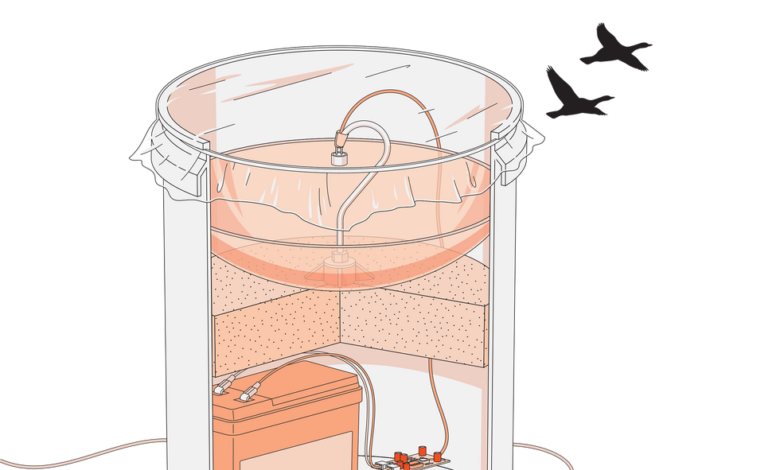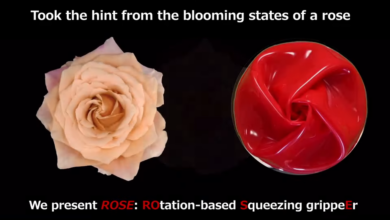Detect Migrating Birds With a Plastic Dish and a Cheap Microphone

Birding is booming. You may realize your local nature spots are especially busy during seasonal migrations, when birds move between their summer and winter grounds. Species that you had been noticing disappear may have been replaced by ones that hadn’t been there before. Or you may have seen migrating birds on the wing—say, a flock of geese flying in their famous V-formation. Even if you’re not a dedicated birder, you’ve probably made such observations throughout your life. So it might come as a surprise to learn that you’ve been missing out on most of this action, which takes place at night. But, as I discovered, with some simple electronics and the right software, you can identify nocturnal migrators with ease!
Birds migrate at night for a few reasons. One is that it helps them to avoid predators. Also, it allows them to use the stars for navigation. A less obvious reason is that traveling at night helps these birds avoid heat stress. And the night air tends to be less turbulent, making flying easier.
These nighttime flights are largely invisible. If you’re lucky, you might view telltale silhouettes by training a telescope on the moon. But during the Second World War, scientists realized that they could readily detect migrating birds using radar. Since then, ornithologists’ radar studies, particularly those that use modern weather radar, have proved immensely successful in showing where and when birds migrate at night.
Radar echoes cannot, however, identify species. But there is another technique that can: recording the calls that birds make during their nocturnal travels.
Incoming sounds are amplified using a parabolic dish made from a plastic bird-feeder cover [top]. A microphone attached at the focal point of the dish is connected to a preamplifier [middle left], which in turns feeds an external sound card [middle right], which connects to a host computer via USB. A large gel-acid battery [bottom] provides plenty of power for long-term monitoring. James Provost
When ornithologist Richard Graber and electrical engineer William Cochrane made the first systematic recordings of nocturnally migrating birds in 1957, they used a microphone attached to a 2-meter-wide upward-facing parabolic dish. But you can get by today with a far more modest setup.
You could, for example, reproduce the gear designed by Bill Evans. On his website he sells a microphone and preamp for this purpose along with guidance on how to package the equipment so that it will hold up to the elements. I explored a different approach, though, one that seemed easier and cheaper.
Evans’s preamp is designed to be insensitive to low frequencies, as these aren’t of interest when you’re recording bird calls. I figured that this feature wasn’t that important, so after testing a few inexpensive options for the microphone and preamplifier, I chose one on Amazon for just US $9.
This circuit uses the venerable NE5532, a low-noise, low-distortion dual op-amp design that’s been used in professional recording equipment since 1979. To make it directional, I unsoldered the condenser microphone from the board, attached a short length of audio cable to it, and mounted it at the focal point of an 8-inch-diameter parabolic dish—or, well, a reasonable approximation of a parabolic dish, as it’s actually a rain guard for bird feeders. You could also purchase a 16-inch-diameter one, but the 8-inch dish served me admirably.
I found the focal point of this dish through trial and error and ran the output of the preamp into an old Creative Labs Sound Blaster external sound card, which had been collecting dust on my shelf. I suspect that just about any external sound card would work fine for this application, including the $34 StarTac model that I use to good effect to monitor solar flares.
To power the preamp, I used a 7-ampere-hour, 12-volt gel-cell battery, which is overkill. But the big battery would allow me to leave the thing running for weeks at a time. Following Evans’s advice, I housed everything in a 2-gallon paint bucket, stretching some plastic wrap over the top to keep rain out.
I placed my bucket o’ electronics on the roof of my porch, running a USB cable from the sound card, out the side of the bucket, and into my office through a window. Then I plugged it into a Windows laptop onto which I had installed Raven Lite, acoustic-spectrogram software made available for free by the Cornell Lab of Ornithology.
Using Raven Lite to compute spectrograms showed just how sensitive this arrangement is. I could easily view, for example, the effect of completely inaudible sounds created by rubbing my thumb and forefinger together a couple of meters away from the microphone.
With the gear in place outside, I started recording at night, beginning in early March, arranging the Raven Lite software to record a series of 1-hour sound files. The great thing about Raven Lite is that you can review hours of recordings just by scanning through spectrograms visually. Checking out a 1-hour-long sound file takes just a few minutes.
This audiogram reveals the presence of bird calls. I uploaded the data to a server maintained by Cornell University that then uses AI to quickly identify the species. James Provost
These files, of course, picked up a lot of sounds: rumbling traffic, screeching cats, wailing sirens, and who knows what else. But once you’ve looked at spectrograms for a while, it becomes easy to pick out bird chirps. There is no shortage of local birds chirping during the day, but after sunset their ornithological cacophony abates, returning again some time before dawn.
The interval in between is where I went hunting for the sound of migrating birds. And after 10 days or so, I found my quarry: chirping that started shortly after midnight, rising in volume for a few minutes before fading away.
Using Audacity, a free audio editor, I extracted a few seconds of the loudest chirping and uploaded the file to Birdnet, where the good folks at the Cornell Lab of Ornithology provide a tool for identifying bird calls. It indicated that the species I had recorded was the killdeer, a type of bird found throughout the continental United States, some populations of which are migratory.
Additional nights of recording and scanning spectrograms turned up other sounds that appeared to be from other kinds of birds on the move, including such migratory species as the dark-eyed junco and Kentucky warbler.
I’ve never been an accomplished bird watcher: I’d be hard pressed to distinguish a sparrow from a wren. So it’s rather satisfying to discover that, with some simple electronics and the right software, I am able to pick out different species of migratory birds flying high overhead through the inky darkness of the night.
IEEE Spectrum




